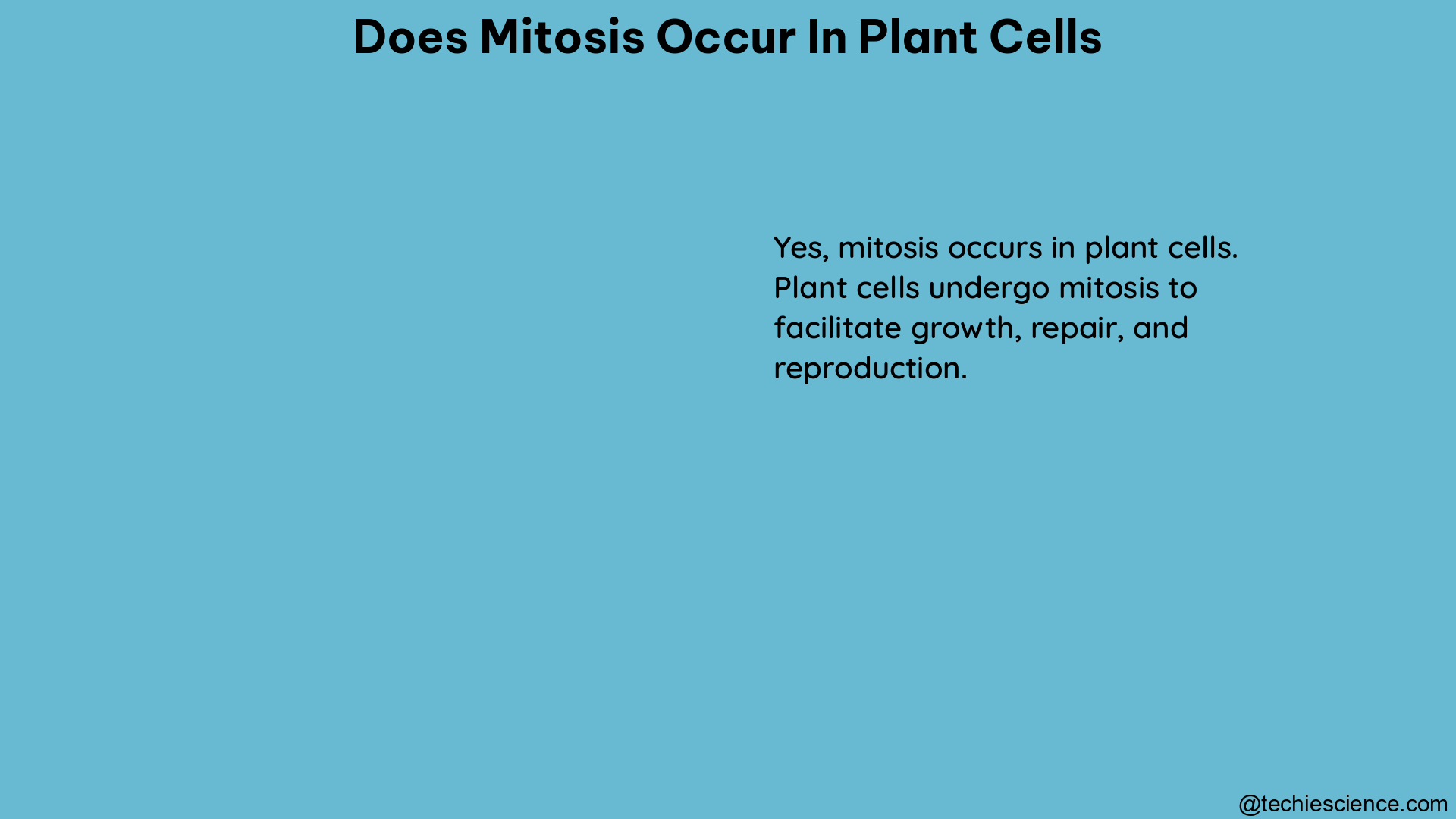Mitosis is a fundamental cellular process that occurs in both plant and animal cells, playing a crucial role in growth, development, and tissue repair. In the context of plant cells, mitosis is primarily limited to the meristematic tissue, which is found at the tips of roots and shoots. This specialized tissue is responsible for the growth and expansion of the plant, and mitosis is the mechanism by which new cells are generated.
Understanding Mitosis in Plant Cells
Mitosis is a highly regulated process that involves the precise duplication and segregation of genetic material, followed by the division of the cell’s cytoplasm to form two genetically identical daughter cells. In plant cells, the process of mitosis is similar to that observed in animal cells, with a few key differences.
Phases of Mitosis in Plant Cells
The mitotic process in plant cells can be divided into the following phases:
- Interphase: During this phase, the cell prepares for division by replicating its genetic material (DNA) and accumulating the necessary resources for cell division.
- Prophase: The chromosomes condense, and the nuclear envelope breaks down, allowing the mitotic spindle to form.
- Metaphase: The chromosomes align at the center of the cell, with their centromeres attached to the mitotic spindle.
- Anaphase: The sister chromatids separate and move towards the opposite poles of the cell.
- Telophase: The nuclear envelope reforms, and the cell begins to divide.
- Cytokinesis: The cytoplasm of the cell is divided, forming two genetically identical daughter cells.
Cell Plate Formation in Plant Cells
One of the key differences between mitosis in plant and animal cells is the formation of the cell plate during cytokinesis. In animal cells, a cleavage furrow forms and deepens, eventually dividing the cell into two. In plant cells, however, a cell plate is formed in the middle of the cell, which eventually develops into a cell wall, separating the two daughter cells.
The formation of the cell plate is a complex process that involves the following steps:
- Vesicle Fusion: Golgi-derived vesicles containing cell wall precursors fuse at the center of the cell, forming the cell plate.
- Cell Plate Expansion: The cell plate expands outwards, towards the cell walls, eventually fusing with the existing cell walls to form the new cell wall.
- Cell Wall Maturation: The cell wall matures, with the deposition of cellulose, hemicellulose, and other structural components.
This unique process of cell plate formation is a hallmark of mitosis in plant cells and is essential for the maintenance of the plant’s structural integrity and the separation of daughter cells.
Regulation of Mitosis in Plant Cells

Mitosis is a highly regulated process, with a number of checkpoints that ensure proper division and chromosome separation. In plant cells, these checkpoints are particularly important, as errors in mitosis can lead to developmental abnormalities and genetic disorders.
Mitotic Checkpoints in Plant Cells
Some of the key mitotic checkpoints in plant cells include:
- Spindle Assembly Checkpoint: This checkpoint ensures that the mitotic spindle is properly assembled and that the chromosomes are correctly attached to the spindle.
- Metaphase-to-Anaphase Checkpoint: This checkpoint ensures that all chromosomes are properly aligned at the metaphase plate before the sister chromatids are allowed to separate.
- Cytokinesis Checkpoint: This checkpoint ensures that the cell plate is properly formed and that the cytoplasm is divided equally between the two daughter cells.
These checkpoints are regulated by a complex network of signaling pathways and regulatory proteins, which work together to ensure the fidelity of the mitotic process.
Quantifying Mitosis in Plant Cells
There are a number of quantifiable data points that can be used to measure mitosis in plant cells. These include:
- Mitotic Index: The mitotic index is the percentage of cells in a given tissue that are undergoing mitosis at a particular time. This can provide insight into the rate of cell division and growth.
- Mitotic Duration: The duration of each phase of mitosis can be measured, providing information about the timing and regulation of the process.
- Mitotic Frequency: The frequency of mitotic events can be measured in different tissues and developmental stages, further elucidating the patterns of cell division and growth.
These quantifiable data points can be used to study the dynamics of mitosis in plant cells, as well as to identify any abnormalities or disruptions in the process.
Conclusion
Mitosis is a crucial process in plant cells, occurring primarily in the meristematic tissue and playing a key role in growth and development. The process is highly regulated, with a number of checkpoints and quantifiable data points that can be used to measure its frequency and duration. Understanding the intricacies of mitosis in plant cells is essential for advancing our knowledge of plant biology and for developing strategies for improving plant growth and productivity.
References:
- Biology EOI Flashcards | Quizlet. (n.d.). Retrieved from https://quizlet.com/22339456/biology-eoi-flash-cards/
- Mitosis in plants: how far we have come at the molecular level? (2002). Retrieved from https://www.sciencedirect.com/science/article/abs/pii/S1369526602002972
- Where does mitosis actively take place in plants? – Socratic. (2017). Retrieved from https://www.socratic.org/questions/where-does-mitosis-actively-take-place-in-plants
- Müller, S. (2019). Cytokinesis in plant cells. Current Biology, 29(9), R358-R359.
- Eleftheriou, E. P. (2013). The plant cell wall. In Plant Anatomy (pp. 63-92). Springer, Berlin, Heidelberg.
Hey! I’m Roshny Batu. I got a Bachelor of Science degree in Botany. In the domain of academic writing, I consider myself fortunate to be a part of the Lambdageeks family as an SME in Bio-Technology. Apart from that, I love designing interiors, painting, and mastering makeup artist skills.